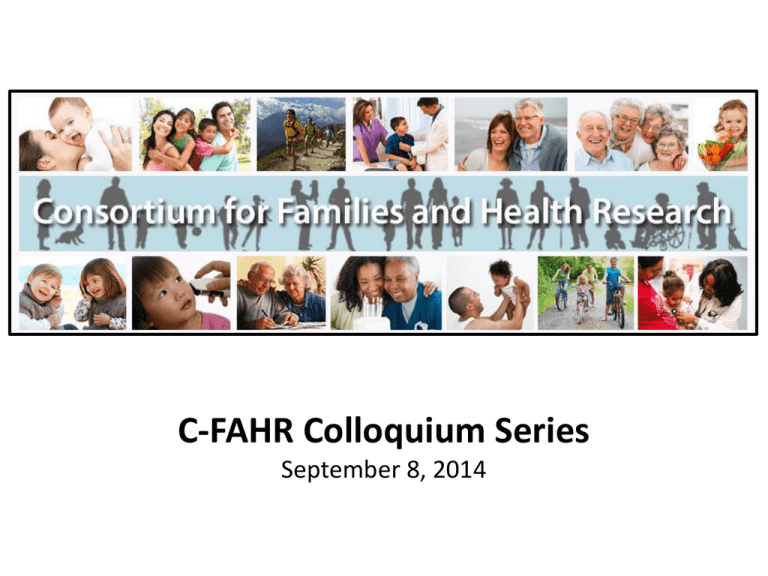The Kick-Off Conversation better title? September 8, 2013 C
advertisement

C-FAHR Colloquium Series September 8, 2014 In Winter 2014 – SVP Ruth Watkins issued a call for proposals to a new program. Led by Cindy Berg, a team of approximately 30 faculty members quickly assembled and quickly created a proposal related to families and health across the lifespan. Our proposal was selected as one of the 4 TEP - Cluster Hiring Initiatives . • Lifespan Health and Wellness • Digital Humanities • Large-Scale Data Analysis/Utah Statistical Center • Society, Water and Climate Cluster Hiring Already Filled • Communicating Complex Health Info Kim Kapinghst arrives in October 2014 Currently Searching – to begin in July 2015 • Quantitative Methods • Intervention Please see website for a flyer to circulate . Search Committee Co-Chairs: Ken Smith & Jon Butner for Methods position. Robin Marcus & Becky Utz for Intervention position. Future Possible Positions • Social Networks • Dissemination & Implementation • Family Diversity and Culture Who are we? What can we become? Purpose of C-FAHR A research consortium to encourage/facilitate interdisciplinary research related to families and health across the life course. • How can the family be used as a vehicle for promoting health and adjusting to chronic illnesses and how such strategies may vary across developmental life stages (infancy, childhood, adolescence, across adulthood)? • Multi-level approach (genetic and environmental factors, methodologies, family interactions and interventions, and healthcare communication) to understanding health across the lifespan. http://csbs.utah.edu/health_family.php Membership Initial team for the TEP proposal had approximately 30 faculty from 11 different departments, representing 5 different colleges/institutes We are now beginning a campus-wide effort to expand the list of Affiliated Members. • • Submit your biosketch to C-Fahr_info@utah.edu. Further details on http://csbs.utah.edu/health_family.php Colloquium Series Monthly events. To be announced. Pilot Grant Program To be announced this fall. • To support interdisciplinary collaborations among Affiliated Members • To facilitate pilot work that will aid in the preparation and submission of external research proposals related to families and health across the life course. The Pac-12 Six-Pack Developing a Comprehensive, Family-Based Model to Health Family Chronic Illnesses are a Family Affair Berg et al. (2007); Beveridge, Berg, Wiebe & Palmer (2006); King, Berg et al. (2013). • Family members view type 1 diabetes as a “family” issue (70.9% mothers, 52.8% children). • When parents collaborate, are warm and accepting, and monitor adolescents’ diabetes management, adherence and HbA1c are improved. Daily Interdependence of Parent and Child in Managing Diabetes b=-5.00* M Persuasiont BGt+1 BGt Berg et al. (2013) Health Psychology Collaborative Family Involvement Has Benefits and Liabilities: Couples Coping with Prostate Cancer Daily collaborative coping associated with lower negative affect and higher perceived coping effectiveness for husbands and wives Berg et al. (2008) Psychology and Aging A potential cost to collaboration may be negative affect transmission Berg, Wiebe, & Butner (2011), Gerontology Family Genetics and Familiality Ken Smith, FCS & Population Sciences HCI No one disputes that genetics matter for psychosocial and socioeconomic phenomena Gene-Environment Interaction is key Familiality-Environment Interaction is even keyer Yet, several social science disciplines have resisted introducing genetics, biology, heritability and familiality into models PSID, NHANES, ADHEALTH now include genetic data and family-based designs 2014 NAS & NIA Sponsored “Expert Meeting on Assessing and Encouraging Interaction between Genetic and Social-Behavioral Models” Utah Population Database Studying Families and Health • Contributes to numerous groundbreaking genetic and public health discoveries spanning the past 35 years • Holds multigenerational pedigrees, 12 generations deep • Links family trees to cancer records spanning the past 50 years using the comprehensive Utah Cancer Registry • Includes critical birth and death records from the past century provided by the Utah Department of Health • Connects to medical records from Intermountain Healthcare & University of Utah Health Sciences Ctr. • Allows for recruitment Brother 105 Sister 98 All Cause Mortality and APOE (e33 is reference) P<.05 2 1.8 1.576 1.6 1.4 1.16 1.2 1 0.8 0.892 e23 0.956 e24 e34 e44 Cox regression, includes controls for baseline age, age2, gender, education, LDS affiliation, FEL 19 All Cause Mortality Hazard Rate Ratios for APOE Genotypes (ε33 is reference) P<.05 Interaction with Education Top 87.5% of Education Bottom 12.5% of Education 3 3 2.6 2.6 2.2 2.2 1.8 1.8 1.4 1.15 1.37 1 2.48 1.31 1.4 1 e34 e44 e34 Interaction between e44 and interval Education p<.05 e44 20 Adversity (Very Young/Old Age) Among Maternal Grandmothers Grandmother Female Fetus Germ Line (Ego) Mother Fetus (Ego) Ego Family Social Contexts of Health Ming Wen, Sociology There have been calls to incorporate the social context into the study of health. Social context may refer to: • • • • • cultural norms networks of social relationships family resources and socialization neighborhood/community environments policies and programs Social contexts, or environments, place constraints on individual choice. They shape health behaviors by: shaping norms enforcing patterns of social control providing or not providing opportunities to engage in certain behaviors reducing or producing stress for which certain behaviors may be an effective coping strategy, at least in the short term. Social environments vary across the life course. Example 1: Adolescent Smoking (Wen, Duker & Olson 2008) Purpose: to examine multilevel factors of adolescent smoking after controlling for the baseline smoking behavior and individual characteristics. Data: National Longitudinal Study of Adolescent Health (first two waves) Key findings Peer, family and school were all important life domains contextually influencing smoking behavior among adolescents. Time spent with peers, best friend smoking and household member smoking were associated with higher risk. Parent-child closeness, parental control, attending a private school and having a higher percentage of Hispanic students were protective factors. None of the neighborhood and state-level factors significant in the final full model (but significant in reduced models). Example 2: Adult Obesity (Wen & Kowaleski-Jones 2012) Purpose: to examine racial/ethnic disparities in risk of obesity based on objectively measured body mass and to explore the role of neighborhood built environment in contributing to these observed disparities. Data: National Health and Nutrition Examination Survey (2003-2008) merged with a range of neighborhood data Key findings Neighborhood socioeconomic status and ethnic heterogeneity negatively linked to risk of obesity controlling for other covariates. The built environment is a significant correlate of obesity risk. Neighborhood walkability (street connectivity and % walking to work), density, and distance to parks are significant covariates of obesity risks over and beyond individual risks Neighborhood factors were not mediators of racial-ethnic disparities in obesity. Family The Role of Health Care Joseph Stanford, Family & Preventive Medicine Do clinicians treat individuals or families? – Family Medicine, Pediatrics, + other primary care How can a family perspective inform and enhance the current transformations in U.S. health care delivery? – Accountable care organizations – Patient-centered medical home Example: Fertility Decisions Office of Cooperative Reproductive Health, DFPM, UU • Fertility decisions and outcomes (family planning, fertility treatment) are usually studied from the woman’s perspective. • Several cohort studies enrolling women and men with separate longitudinal assessments of each over time. Example: Fertility motivations (Stanford PI, Office of Population Affairs, HHS) Purpose: To investigate couple motivations, intentions, behaviors, and outcomes in family planning Data: Cohort, multicenter (CEIBA study) Key finding: Dis/concordance of couple feelings about hypothetical pregnancy in each cycle Women Men Unhappy Neutral Happy TOTAL Unhappy 5.4% 2.7% 5.4% 13.4% Neutral 3.1% 4.0% 11.1% 18.2 Happy 4.8% 6.5% 57.1% 68.3% TOTAL 13.3% 13.1% 73.6% 100% Example: Marital fertility (Stanford and Smith, J Biosoc Sci 2013) Purpose: Investigate the association between socioeconomic status, religion and marital fertility in Utah. Data: Utah 1996 Health Status Survey Key finding: Income positively associated with fertility among LDS; negatively associated among non-LDS. 4 3.5 Children Born 3 2.5 2 1.5 1 0.5 0 <$35,000 $35-55,000 >$55,000 non-lds 2.44047 1.84031 1.39983 inactive lds 1.95233 2.03878 2.07826 active lds 2.53924 3.5008 3.39667 Family Methods & Data Methods & Data Jonathan Butner, Psychology Family relationships are complex webs of influence We need different metaphors for understanding families and health and methods/statistics that enable those different metaphors – I use Dynamical Systems Theory – Multiple outcomes measured repeatedly through time Two Example Metaphors: – Family Health as a Coordinated System – Family Health as a Map Health as Coordination Coordination is a taxonomy of how ‘things’ move together through time We can build models in Structural Equation Modeling specifically designed to extract the coordination taxonomy Added Different Natural Tendencies for X and Y In Sync at 3:1 Ratio A Anti-Phase 5:1 Ratio, weaker Synchrony C B No Synchrony D From ADAPT Study Where Mom/Dad Monitoring are Entrained and Adolescent Efficacy/Self Control are Synchronized 9 Predicted Average Values 8 7 6 SE 5 BSC 4 MM 3 DM 2 1 0 1 2 3 4 Time 5 6 (Butner, Berg, Baucom, Weibe, In Press Multivariate Behavioral Research) Health as a Map Maps allow us to visualize very complex patterns of behavior. For example, a pair of Time Series translates into a trail We can Use Math/Statistics That Directly Parallel Topographical Features in Maps Exploratory or Confirmatory Exploratory Map Based On All Families We can then examine what changes the Map giving a very complex understanding of the family Probability of Being in Valley (Color Coded) Estimated via Mixture Modeling Adolescent Self Control Family Methods & Data Intervention Dissemination Intervention & Dissemination Rebeccca Utz, Sociology • Does translation or dissemination of health promotion or health management programs/concepts differ when using this comprehensive family-based perspective? Yes • Does a comprehensive family-based perspective improve the success of intervention efforts? Yes Example 1: Bereavement (Utz, Caserta, Lund, 2013 -- R01AG023090-02 from NIA) Purpose: To design , implement, and test a theoretically-based, group-delivered model of support for recently bereaved spouses. Data: Randomized intervention design, with longitudinal survey follow-up Key findings: Bereavement-related outcomes showed a general trend of adaptation or recovery following the loss. However, there were no differences between treatment and control groups • Need for individually delivered and/or individually tailored interventions • Family-based perspective Example 2: Adolescent Obesity (Coffield, Metos, Utz, Waitzman, 2011) Purpose: To evaluate the effects of school wellness policies mandated by the 2004 Child Nutrition and WIC Reauthorization Act on the prevalence of overweight and obesity among adolescents. Data: Utah Population Database, birth certificates and driver license linked to school policy data for a cohort of children born 1990 to 1992 Key findings: • Each additional component included in a district's wellness policy was associated with as much as: 3.2% lower odds in the prevalence of adolescent overweight (OR = .968; 95% CI = .941-.997). Effect was primarily driven by nutrition related policies, not physical activity. • When multivariate regression models controlled for individual, maternal, and familial characteristics, as well as characteristics of school district (environenet). The policy effects were dampened, but remained significant. Comprehensive, Family-Based Model of Health Family Intervention Dissemination Discussion of this model’s potential and promise Methods & Data Upcoming Events C-FAHR Symposium October 6, 4pm to 8pm at the Officer’s Club Keynote Address by Dr. Rena Repetti, UCLA Department of Psychology. Followed by a “Research Mixer” and Cocktail Hour where we can begin to learn about other research and researchers on campus. October 7, morning to 130pm small group discussions related to the data/analytic considerations required for a comprehensive family-based perspective, and brainstorming related to forming new interdisciplinary collaborations Submit your biosketch to become an Affiliated Member C-FAHR-info@utah.edu







